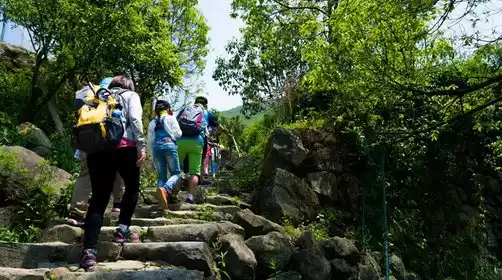Day 1 Hangzhou → Xiaoshan Daijia → Hangzhou
All day
Meet at the Huanglong Seafood Food Stall between 7:00 and 7:30 AM and sign in. Board the bus and depart. Along the way, your guide will guide you through the fun, introducing you and explaining the itinerary, all while enjoying
a lively atmosphere. Arrive at the starting point around 9:30 AM, disembark, warm up, and then embark on your trek. From Jianshanxia Village, ascend the mountain. Crossing a small bridge, you'll find an ancient path nestled in a bamboo forest, a tranquil setting filled only by the chirping of birds. Reaching the top, you'll ascend along the steps, crossing Yuqingling Mountain. Lunch will be available along the way, offering panoramic views of the Yunshi Mountains. After lunch, rest briefly before continuing on your journey. After passing Despair Slope, you'll pass Guolaoying Rock, cross Xiaohuangling, reach the summit of Chuanwu Mountain, pass Xiangtianling Reservoir, and reach Yangjia Creek. Descend from Jianshanxia Village. The total hike is 14 km, with a total elevation gain of approximately 1,200 meters. The three ascents and descents of Despair Slope require a lot of effort. Due to the challenging nature of the trail, there's a closing point at the foot of Chuanwu Mountain. All hikers arriving after 3:00 PM will be asked to leave. After reaching the top of Ship Dock Mountain, we started to descend. It gets dark early in the mountains, and we went down through the bamboo forest, which blocked the light. We might have to march at night, so a headlamp was necessary.
We arrived at the foot of the mountain around 17:00. The bus waited there for a long time. After gathering, we got on the bus and returned.
We arrived in Hangzhou around 18:30. We hugged each other affectionately and kissed goodbye with tears, looking forward to traveling together next time.






